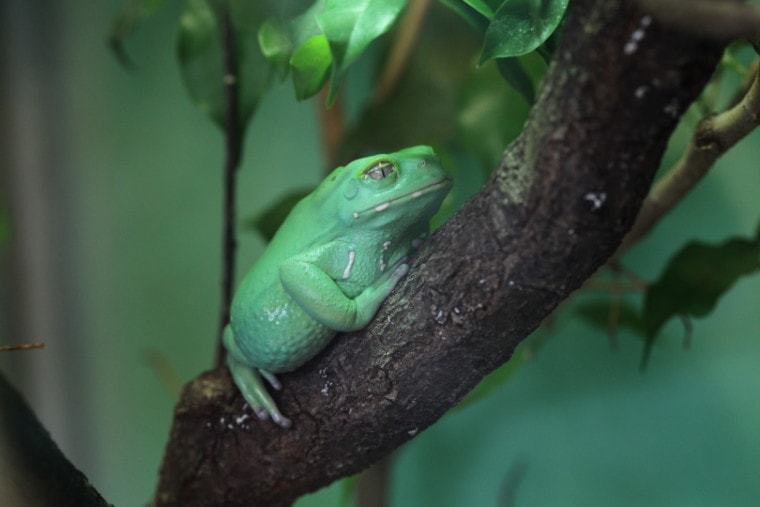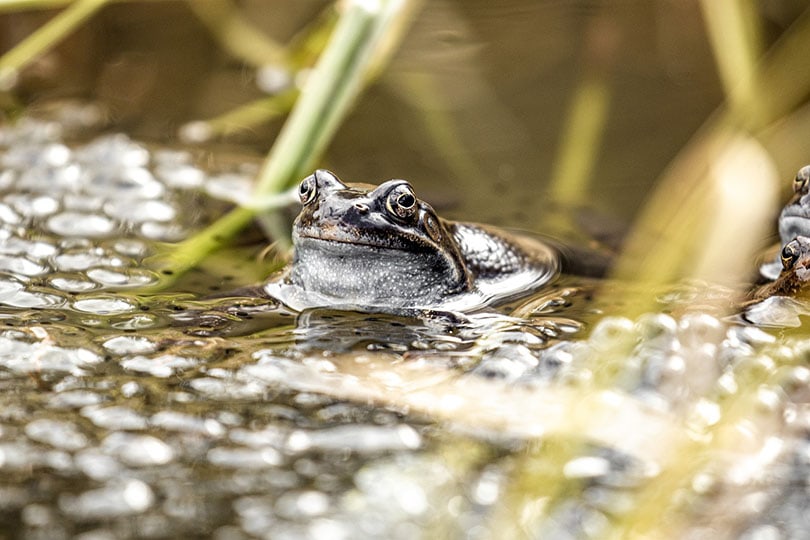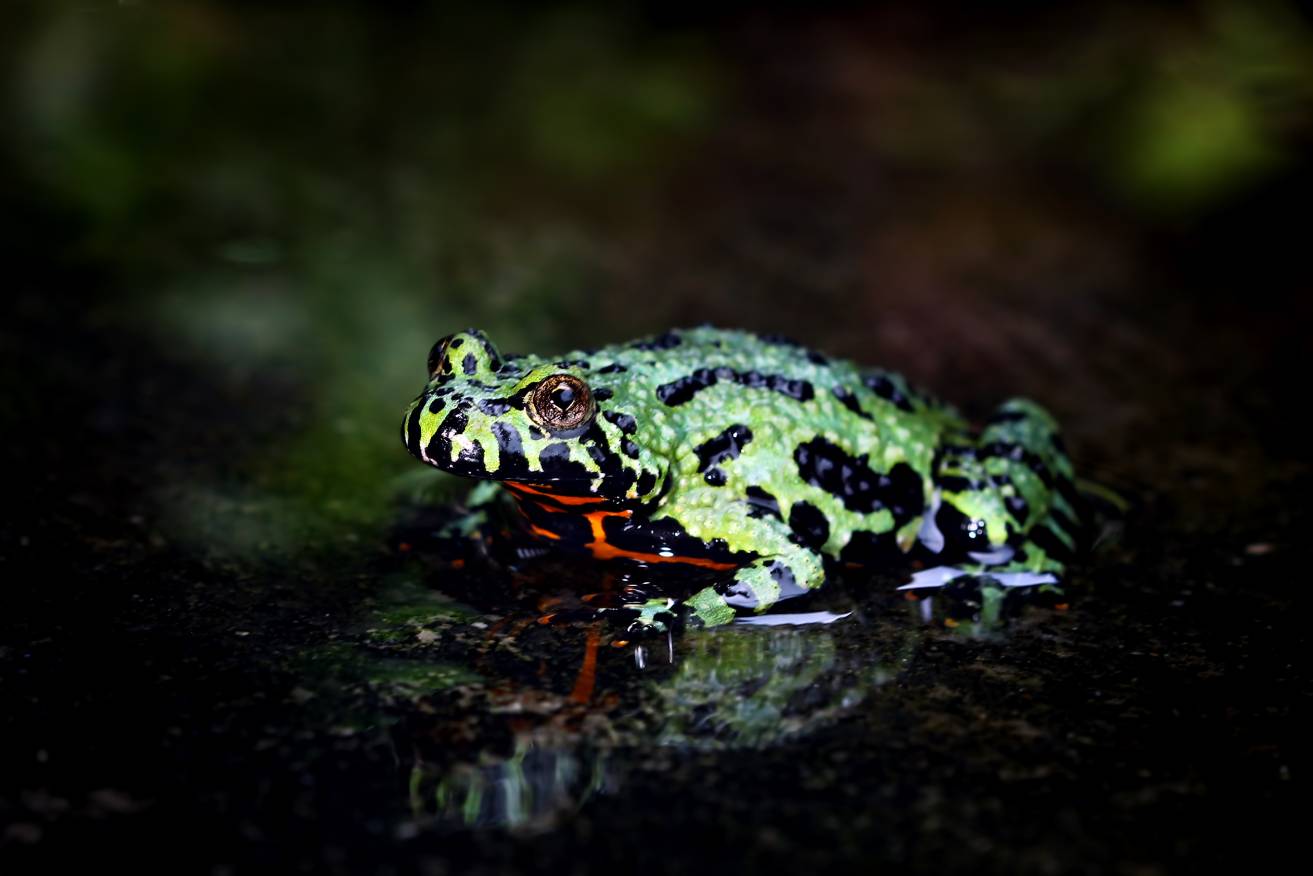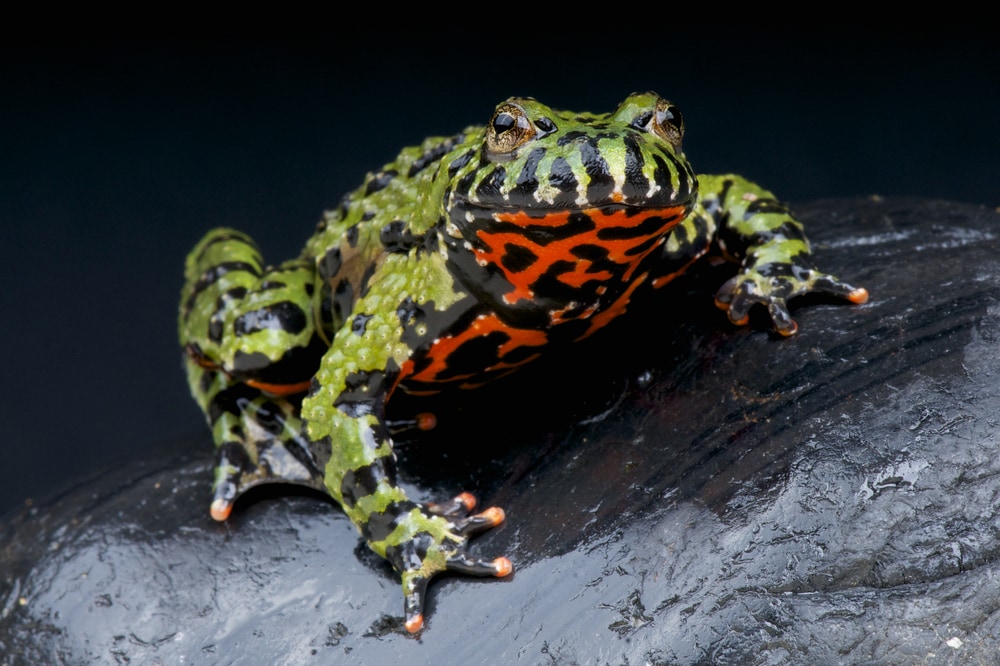
Waxy Monkey Tree Frogs are gorgeous, portly little amphibians that like to climb and hang on a branch all day. This allows them to camouflage themselves, like chameleons, and to go unnoticed by predators. But this feature can also make them a bit boring to keep as pets if you can’t afford to stay awake all night to finally watch them play in their surroundings. However, if you’re more of the night owl type, waxy monkey frogs could be your perfect companion!
 Quick Facts about Waxy Monkey Tree Frog
Quick Facts about Waxy Monkey Tree Frog
| Species Name: | Phyllomedusa sauvagii |
| Family: | Phyllomedusidae |
| Care Level: | Intermediate to Advanced |
| Temperature: | 75-85° F |
| Temperament: | Hardy, long-lived, docile, easy to care for |
| Color Form: | Lime green with white spots on their belly |
| Lifespan: | 8 to 10+ years |
| Size: | 3 to 4 inches |
| Diet: | Carnivore, primarily insects |
| Minimum Tank Size: | 10 gallons |
| Tank Set-Up: | Terrarium with plants |
| Compatibility: | Can be kept individually or in small groups of 2 to 8 animals |
Waxy Monkey Tree Frog Overview
The waxy monkey tree frog is a relatively large frog native to warm temperate forests of southeastern Bolivia, most of Paraguay, southern Brazil, and northern Argentina. It lives mainly in the dry forests of this region. So no, it’s not an Amazonian animal, and it certainly doesn’t enjoy extreme humidity.
This friendly, gray-eyed frog gets its name from a specific technique it uses to resist periods of drought: it covers its body with a waxy substance, which greatly reduces moisture loss through the skin. This secretion is then diffused on the skin by the animal itself, using its paws.
Like most members of the same family, this species is nocturnal. It’s not one of the most spectacular and entertaining animals to observe during the day, as it stays still most of the time. Be aware of this peculiarity before buying it. Besides, they are calm-looking animals and relatively slow compared to other frogs.

How Much Do Waxy Monkey Tree Frog Cost?
Prices vary greatly, depending on breeders or specialized pet stores. Expect to spend at least $50 for a captive-bred specimen. And above all, do not make the mistake of buying your frog online because it will be impossible for you to know the sanitary conditions of your little companion.
Also, be aware that the import conditions of these exotic animals are often atrocious, so do your research beforehand and only go to trusted sellers.
Typical Behavior & Temperament
Waxy monkey tree frogs are friendly, calm, and slow-moving amphibians. They are nocturnal and will be more than happy to spend the whole day perched on their branch. At night, they finally get busy eating, stretching their limbs, and climbing into their enclosure.
They tolerate some handling, but to some extent, don’t touch them if you don’t have to. Always move them carefully if you have to clean their tank. They quickly become stressed and therefore are not suitable pets for children either.
Appearance & Varieties
These fascinating frogs are always lime green, with a white lateral line. This species also has white spots on the belly. Their muzzle is short, almost squashed, and their size can reach up to 4 inches. The fingers are long and have suction cups, which allows them to climb in the branches, like perfect little tree monkeys.

How to Take Care of Waxy Monkey Tree Frog
Habitat, Tank Conditions & Setup
Tank
Waxy monkey tree frogs are fairly good-sized arboreal animals; the terrarium should have a minimum volume of 25 gallons per couple (20 gallons per additional animal) and be taller (ideally 25-30 inches high) than long. It is perfectly possible to have a group of these tree frogs cohabits, provided they have the necessary space.
The terrarium should include plants that will provide hiding places for the animals. You can use a variety of tropical plants, as long as they are strong enough to support the weight of the frogs. From this point of view, a large terrarium is essential, not only for animals but also to place plants of larger sizes, therefore more resistant.
You can also add dead branches to the top of the terrarium to enrich the environment of these climbing frogs.
An aquatic part is necessary to collect the tadpoles during the breeding season. Adults also like to take a small bath from time to time. Filtration is not essential if you change the water from time to time. Do not exceed 25% of the total area of the terrarium.
Bedding
You can use two types of substrate for the land part:

Temperature and Humidity
Waxy monkey tree frogs thrive in temperatures between 75-85° F. They don’t tolerate high humidity, though: it should oscillate between 40 and 60%, which is relatively low. It is, therefore, necessary to have excellent ventilation; otherwise, the aquatic area will always make everything wet. The terrarium cover must also be screened.
To do that, cut four cleats of three inches in section and glue them with wood glue to the top dimensions. Then, stretch this frame with a mesh with small holes. Frogs, who are good climbers, will not be able to escape. But the terrarium will breathe, and the air will remain relatively dry. The frame can rest directly on the glass walls, or better still, on side reinforcements glued inside, all around the tank.
Always watch out for possible escapes. Remember that waxy monkey tree frogs are escape artists, so don’t leave the terrarium open or even ajar.
Lighting
Waxy monkey tree frogs are primarily nocturnal animals. Lighting during the day is, however, essential for both animals and plants. You can either use conventional daylight neon tubes on the market (without UV) or a tube specially made for terrariums (with UV).
Do Waxy Monkey Tree Frogs Get Along with Other Pets?
Unlike other exotic amphibians, waxy monkey tree frogs are not territorial or aggressive towards their congeners. You can safely put a couple (if you want to breed them) or multiple specimens together in the same terrarium. But do not mix them with other species and be careful with your other pets; waxy frogs excrete toxins through their skin which can be harmful to other animals.

What to Feed Your Waxy Monkey Tree Frog
Anything that moves and the mouth’s size will be accepted: flies, mealworms, crickets, spiders, butterflies, earthworms, etc. You can try to find these insects in your garden (it is better to wash them if there is a risk of pesticides) or buy them directly from the pet store or in fishing stores. You can also start breeding those insects if that’s your thing!
Be careful not to feed them with chitinous invertebrates (chitin is the shell of insects), such as woodlice or mealworms. This is because chitin is not very well digested.
Maximum variety is ideal for avoiding deficiencies. The best balance is to swing between grasshoppers, crickets, and earthworms. After a while and gaining your frog’s trust, you might try feeding them some thawed dead food – shrimp, fish, beef. At first, the process will seem laborious, but it will get easier after a while. But remember that these animals mostly eat in the evening.
Adults should be fed two or four times a week and in good quantity given the size of these animals. Growing juveniles should be fed daily. Besides, many breeders put a little vitamin supplement on their food. Others may think that it does more harm than good. Let’s say moderate doses of vitamins every two weeks shouldn’t hurt.
Keeping Your Waxy Monkey Tree Frog Healthy
Due to a unique adaptive characteristic, captive waxy monkey tree frogs may suffer from a rare disease in amphibians. Indeed, the fact that they like to spend most of their time under a UV lamp, as chameleons do, causes a significant drawback for these amphibians: stones in the bladder. This problem is common in captive frogs and almost unknown in the wild.
To defend itself against dehydration, the frog will indeed concentrate its urine, which eventually saturates its urinary tract.
So, what can you do to avoid this life-threatening condition? The answer is simple: make sure your frog gets a varied diet. Researchers have indeed established a strong correlation between a diet composed exclusively of crickets and the development of stones in the bladder. Therefore, your amphibian must eat a varied diet, which is not too high in protein. You may need to take the picky cat approach, which is if they are hungry enough, they will eat the food you give them.
To sum up, the trick to keeping your waxy monkey tree frogs healthy is to keep them well hydrated without overdoing the humidity. Once this routine is established, good nutrition and a pleasant habitat should keep your pet healthy and happy for the next eight to ten years.

Breeding
Breeding waxy monkey tree frogs in captivity is still poorly documented, but what is reported is consistent with breeding other members of the Phyllomedusidae family.
In the wild, breeding is triggered by increased rains from October. In terrariums, this means in October spraying water two or three times a day to mimic conditions in the wild. You will also need to increase the feeding frequency to allow the sexual maturation of females. Females usually are larger than males. During the mating season, they develop a large black dot on the inside of the thumb.
After mating, the female will lay a mass of gelatinous eggs on a sheet (often rolled into a cone by the animal to protect the eggs against desiccation) above the water:
Are Waxy Monkey Tree Frogs Suitable for You?
Well, it depends. Waxy monkey tree frogs come from a particular native environment that is not that easy to recreate. These are generally not for beginner amphibians’ keepers. They are better suited to frog enthusiasts who have previously cared for several other frog species.
But if you’re willing to spend some extra time at first to set up a habitat adapted to their specific needs, and don’t mind having to watch them thriving only at night time, then the waxy frog could be your dream pet!
Featured Image Credit: Vladimir Wrangel, Shutterstock

 Quick Facts about Waxy Monkey Tree Frog
Quick Facts about Waxy Monkey Tree Frog





